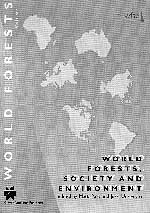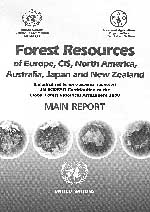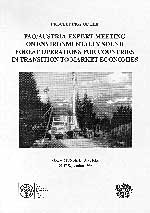FAO Yearbook of Forest Products now available in Arabic and Chinese
FAO Yearbook of Forest Products 1994-1998. 2000. FAO Forestry Series No. 33/FAO Statistics Series No. 155. Rome, FAO. ISBN 92-5-004407-0.
The 52nd issue of the FAO Yearbook of Forest Products contains annual data on production and trade in forest products for the years 1994 to 1998 and on direction of trade in 1997 and 1998. With this issue of the yearbook, in keeping with FAO's commitment to increasing access to forestry information and to best serve its member countries, language coverage has been expanded to include Arabic and Chinese in addition to English, French and Spanish. This edition also benefits from expanded cooperation in gathering forest sector statistics among a number of international organizations including the Economic Commission for Europe (ECE), the Statistical Office of the European Communities (EUROSTAT) and the International Tropical Timber Organization (ITTO).

As in previous issues, the tables are extracted from FAO's FAOSTAT database on forest products. The full forest products time series starting in 1961 is available on the Internet at http://apps.fao.org/forestry, on diskette (FAOSTAT PC) and on compact disc (FAOSTAT CD).
The FAO Yearbook of Forest Products compiles statistical data on basic forest products for all countries and territories of the world. It contains series of annual data on the volume of production and the volume and value of trade in forest products. It includes tables showing direction of trade and average unit values of trade for certain products. Statistical information in the yearbook is based primarily on data provided to the FAO Forestry Department by the countries through questionnaires or official publications. In the absence of official data, FAO makes an estimate based on the best information available.
The main yearbook tables report the volume of production, consumption and trade, as well as total and unit values of trade, for every country and type of forest product. Additional tables show the most important countries in terms of production, consumption and trade of forest products in 1998, and the bilateral directions of trade for major product categories.
A global prospectus on forests, society and environment
World forests, society and environment. M. Palo and J. Uusivuori, eds. 1999. World Forests Book Series, Vol. 1. Dordrecht, the Netherlands/Boston, Massachusetts, USA/London, UK, Kluwer Academic Publishers. ISBN 0-7923-5594-6.
This book presents 40 research-based reviews of globally relevant issues related to forests, society and the environment from an independent and non-governmental point of view. It has been produced under the auspices of the World Forests, Society and Environment Research Program, a joint effort of the European Forest Institute, the Finnish Forest Research Institute and the United Nations University Institute of Advanced Studies.

Part I, Editorial Perspectives, considers the ongoing globalization of forests, societies and the environment. Part II reviews worldwide trends of significance for the future of forests, forestry and forest industries. An important conclusion is that issues external to the forest sector such as demography, urbanization and technological developments have a greater impact on these trends than do forest sector issues.
Part III looks at the value of the goods and services of forests - tangible and intangible, market and non-market - and concludes that failure to recognize their full value is an important impediment to sustainable development. Part IV presents global forestry themes including deforestation, trade and the environment, climate change and biological diversity, with the aim of stimulating wider discussion. Part V complements this discussion with analyses of key regional issues. Part VI focuses on the special issue of forestry in countries in transition to market economies.
The main message to be drawn from the reviews in World forests, society and environment is that cooperation on a global scale is essential if solutions to the problems facing the world's forests are to be found. This volume and future publications in the series are intended for a wide range of readers including participants in national and international bodies concerned with forests and related policy issues (both governmental and non-governmental); students, teachers and researchers; the private sector; the general public; and the media.
Forest resources of industrialized temperate and boreal countries
Forest Resources of Europe, CIS, North America, Australia, Japan and New Zealand (industrialized temperate/boreal countries). UN-ECE/FAO contribution to the Global Forest Resources Assessment 2000. Main report. 2000. Geneva, Switzerland, United Nations. ISBN 92-1-116735-3.
Recent, reliable and internationally comparable data on the extent, location, nature, condition and productivity of, and changes to, the forest resource, at the global and regional levels, are vital to any serious discussion of policy- and decision-making relating to wood supply, industry location, protection of biodiversity, climate change and a whole host of topics linked to forest resources.

The global Forest Resources Assessment 2000 (FRA 2000) is the response to this need. This volume summarizes the forest resources assessment for 55 industrialized temperate and boreal countries, coordinated by the UN-ECE/FAO secretariat in Geneva. The data on temperate and boreal forests will be integrated into the global data set being prepared within the framework of FRA 2000.
According to the report, the total area of forest and other wooded land in these countries in the late 1990s was nearly 2 500 million hectares, or somewhat less than half the total land area. Of the total, 68 percent was classified as forest and the remainder as other wooded land. About 63 percent of the total area of forest in the industrialized temperate and boreal countries is classified as available for wood supply.
Not all countries could provide data on changes in forest area over time, and there are doubts about the consistency of data among countries. However, best estimates indicate that there was an average increase in area of about 1.95 million ha per year, of which more than 600 000 ha were forest and the remainder other wooded land. The largest reported changes were in the Russian Federation, which had an average annual decline in forest area of 1.1 million ha, but an increase of 1.6 million ha per year in other wooded land.
The current assessment differs from earlier assessments in that it has also attempted to include information on the condition of forest resources. Overall, the most important reported causes of damage to forests were insects and fire. The information provided highlights the difficulties of making such an assessment.
In addition to the statistical and descriptive information, the report offers analyses of ownership and management status, wood supply and carbon sequestration, biological diversity and environmental protection, and protective and socio-economic functions.
This volume will be useful to governments and the international forest policy community, as well as a wide range of other groups including the scientific community, forest industries, non-governmental organizations, the international conventions on biological diversity and climate change and the general public.
Two FAO publications on sound forest harvesting

Environmentally sound forest infrastructure development and harvesting in Bhutan. N. Winkler. 1999. Forest Harvesting Case Study No. 12. Rome, FAO.
Case studies on environmentally sound harvesting operations form part of a series of initiatives carried out by FAO's Forest Harvesting, Trade and Marketing Branch to promote environmentally friendly
forest engineering practices. The current study was undertaken to investigate the applicability and efficiency of low environmental impact, environmentally sound road construction methods in the Himalayan region of Bhutan. The results show clearly that low impact methods are both feasible and more efficient in the long term, even though they represent larger initial investments than the traditional tractor-based road construction methods. The study also provided an opportunity for testing ways to improve the stripwise clear felling associated with long-distance cable crane logging, which is the most common logging method in the country. It is hoped that this study will help to raise interest in and commitment to the adoption of more environmentally friendly practices throughout Bhutan and in other areas with delicate forest ecosystems.
Proceedings of the FAO/Austria Expert Meeting on Environmentally Sound Forest Operations for Countries in Transition to Market Economies. 1999. Rome, FAO.

The Expert Meeting, held in Ort/Gmunden, Austria, from 20 to 27 September 1988, was organized to exchange experience and information on the development of environmentally sound forest operations in countries undergoing transition to market economies; to provide information on environmentally sound forest operations
based on the experience of private forest enterprises supported by administrative, institutional and financial programmes as established in Austria; and to demonstrate appropriate forest operations involving individual forest contractors and forest enterprise personnel in small-, medium- and large-scale forest operations. Participants were from Bulgaria, Croatia, Estonia, Hungary, Latvia, Lithuania, Poland, Romania, the Slovak Republic, Slovenia and
Ukraine. This volume offers
the papers presented during
the meeting, both by the country participants and the Austrian organizers, as well as a summary of the field excursion to observe road planning in steep terrain. Comprehensively, the papers represent a valuable review of measures being adopted to meet the challenges facing the countries with economies in transition.